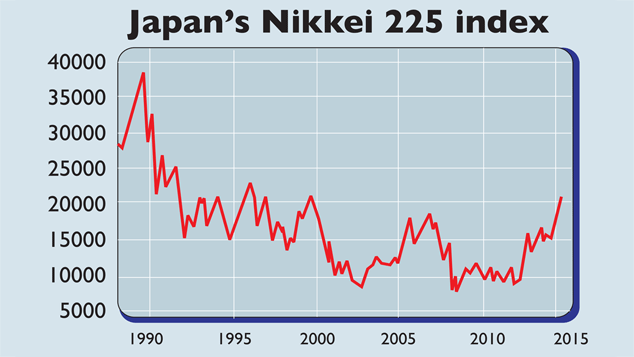
Japanese stocks have had a nasty summer, sliding by around 10% amid global jitters over China. But it isn’t just the state of Japan’s giant neighbour that has investors unnerved. “Abenomics”, Prime Minister Shinzo Abe’s plan to revive the economy after two decades of stagnation, “appears to have stalled”, says the Financial Times. A key plank of Abenomics is a vast quantitative-easing (QE), or money-printing, programme, designed to produce inflation of 2%.
The Bank of Japan has been buying around $55bn of bonds a month. That’s less than the monthly $85bn the US central bank bought under its QE programme, but in an economy three times smaller. Yet core inflation, which strips out volatile fresh food prices, has just fallen into negative territory for the first time in three years.
There is also little sign so far of inflation expectations and wages rising. In the year to July, earnings rose by just 0.6%. “Consumers still appear shell-shocked” by last year’s rise in the consumption tax (VAT), says the FT. That “knocked the wind out of the recovery”.
Meanwhile, progress on structural reform has been relatively slow. One key task, says The Economist, is to prepare the population for more immigration to make up for the shrinking workforce. “Keeping low-paid foreigners out is one reason why, in the five years to 2012, about half a million Japanese stopped work to care for their ageing parents.”
Still, the gloom looks overdone. The Bank of Japan could boost its QE purchases as soon as next month, reckons Capital Economics. That should mean further yen weakness, giving Japan’s exporters another boost. Meanwhile, although the structural reforms remain a work in progress, lower corporate taxes and improvements in corporate governance are bullish. State pension funds are also being encouraged to buy equities.
Japan enjoys “an impressive lead” in industries such as medical devices, robotics and high-performance materials, says Fidelity’s Tom Stevenson in The Sunday Telegraph. It also spends more on research and development than anywhere bar South Korea. On top of that, says Capital Economics, Chinese data are set to improve as stimulus measures work their way through, and the yen’s fall
could gain impetus if American interest rates rise further or faster than currently expected. The consultancy thinks the Nikkei could gain another 30% by the end of 2016.